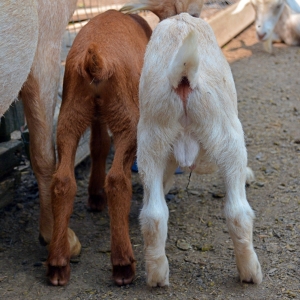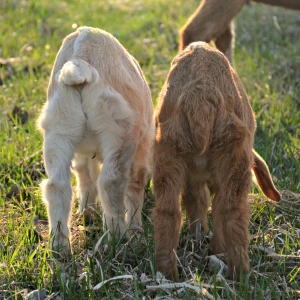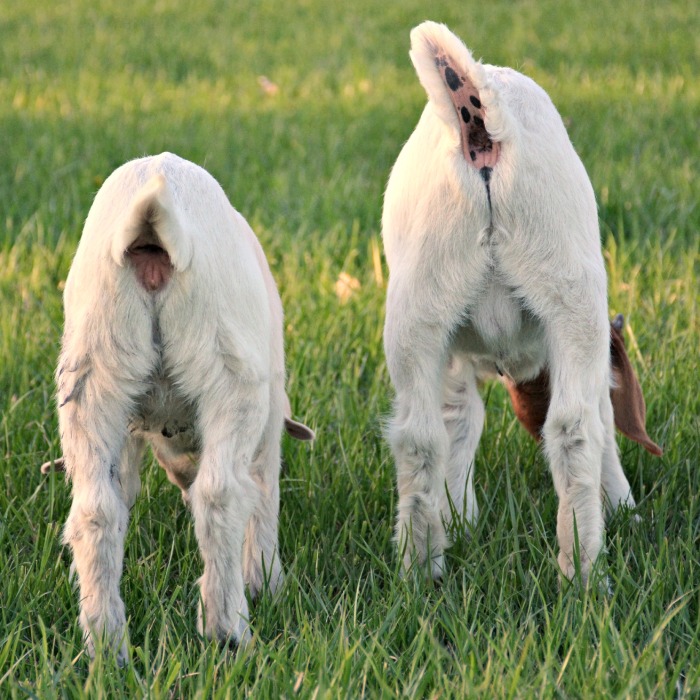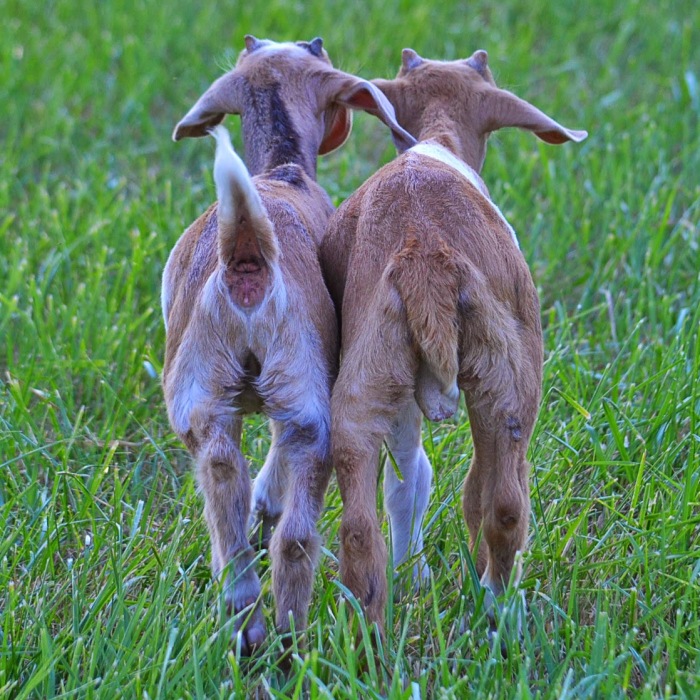When I brought home my first five nannies, three of them were plain Janes, but two had decorations: those cute fuzzy dangling flaps of skin called wattles.
I admit, I didn’t like the wattles on goats. I thought it just looked weird. Over time, however, I’ve learned to appreciate their goatie jewelry.
Minnie Pearl has long even wattles. Yes, those little tags hanging down helped earn her name.
Meg has unevenly placed wattles, just a bit lopsided.
I noticed over time that the only goats with kids who had wattles were Minnie and Meg. About half of Minnie’s babies have had wattles, but none of her daughters ever did. Meg has had way more kids with wattles than without. Below is her oldest daughter, Muffin, Meg in the middle, and Fancy, her youngest daughter, all showing off their wattles.
Muffin had wattles, but her twin sister didn’t.
Meg’s middle daughter, Jilly, has the cutest little fuzzy wattles.
Fancy is the only one we’ve had with these cute little ear wattles!
We are now getting into Meg’s grandkids, who are also showing that dominant trait. It’s hard to see the wattles on Muffin’s daughter, Jetty, but she has them.
Because some people don’t like wattles, they remove them at birth. This gives the inaccurate impression that goats randomly have wattles. That really is not the case at all.
This year my science students were studying genetics–a simple Punnett square can explain the genetics of wattles. Even though most goats don’t have wattles, they are the dominant trait. It only requires one parent to donate the gene for having wattles for them to show up. Not having wattles is recessive, and requires both genes from the parents to be that recessive gene.
W-dominant trait having wattles (My girls are on the side)
w-recessive trait absence of wattles (Buck without wattles on top)
|
w |
w |
|
|
W |
Ww |
Ww |
| w | ww |
ww |
As you can see, statistically, about half of their babies should have wattles. Although Meg really has had more like ninety percent of her babies with wattles.
Source of Information: HERE
Minnie is retired from having babies, and we are waiting on Meg to have her final babies. Soon we’ll know how many more little wattled kids we’ll have running around. She’s in labor as I post this. I was hoping to show you her adorable kids, but I guess I’ll have to name one Xena and introduce you next week.
If you haven’t commented to enter my giveaway for homemade bath salts and goat milk soap, there’s still time. Just click on the picture in my sidebar.
Be sure to visit Jenny Matlock for more posts on the letter W.



























I had no idea what wattles even were until now! Very interesting and informative!
Thanks. I try to do my part with the goatucation of the world.
Hi again!
Great ‘W’ post -as always. So interesting and informative!
Looking forward to *seeing* you again next time,
XOXO LOLA:)
Btw Alphabe-Thursday
Glad you enjoyed your stop here.
How is it so certain that wattles are a single-gene dominant trait? While your experience with Meg’s offspring, 90% of which had wattles, is POSSIBLE with a single-gene dominant trait, isn’t it more likely that something else is going on? Your article doesn’t include the genotypes (or phenotypes) of the various fathers, that I assume were responsible for half the kids’ genetics. IF a single-gene dominant trait, then how to explain goats with only one wattle, or three? A mama and papa goat without wattles would NEVER have a did with wattles … is this the case?
How is it explained that although wattles are a dominant trait, that “most goats don’t have wattles”?
If you look back in the article, I link to my source. None of the bucks I had at the time had wattles. It sometimes might be confusing because people will remove wattles, so you can’t see that a doe had wattles. I have never had a kid born with wattles that did not have a parent with wattles. Again, if someone had wattles removed, it might be hard to know that they did have them. Now, I have a buck with wattles, and about half of his kids have had them.
Most goats don’t have them because people remove them. Some breeds have selectively bred them out. It’s the same with horns. Being polled (not having horns) is a dominant trait; however, polled goats also have more defects, so people don’t necessarily keep polled goats as much.
Darling as usual! Can’t wait to see “x”!
xxoo,
RMW
I admit I’m getting anxious to meet the little x as well. Thanks for stopping by.
Honestly, I never knew about wattles until you started talking about them, I never noticed them either. I’m looking at goats in a whole new way.
Interesting post.
Oh, DH says we don’t have enough land here for more than 3 goats, (like he knows) it’s not quite 1/2 acre that we could fence in and he says it would cost too much to make it worth while. 😦
But think of all the goat kisses you could get from three goats! Not to mention milk.
Ear wattles! How great~ Love all your nannies’ names…Muffin, Jetty, Jilly 🙂
I’m really having to start to be creative to find new names. Aren’t those little ear wattles the cutest?
I learned about wattles last year when my youngest daughter bought two pygmy goats. They are just the cutest little things. I love how you name all of your kids…so cute.
Well, you have to name family members don’t you? We don’t do the whole number them thing.
I’ve seen them on some pigs too. I think they’re so odd… 🙂
I didn’t know pigs had them! I got to learn something today too.
Wattles!! I love that word! Thanks for all the interesting info!
Thanks for stopping by. Glad you found it interesting!
Well I certainly learned something today about wattles and goat geneology! Fun!
You’d be amazed at all the science lessons I can incorporate goats into!
Hi Teresa, thanks for the informative lesson on the Mendelian inheritance of goat wattles. I was looking at two little babies today and we were noticing the wattles. I now am going to incorporate it into my lecture in Dec. I am a genetics lecturer. This will be fun! I also think there must’ve been a use for them once upon a time. Do you know what their function could’ve been? Thanks so much.
To the best of my knowledge, they have no purpose other than decoration.
I love getting to see your goats and their wattles.
I’m so glad you enjoy the goats because I LOVE talking about them!
How interesting about the wattles. I had no idea that some goats have them.
I think it’s so weird that the dominant trait is the one people don’t know about.
Hi there,
I’m passing the Versatile Blogger award to you
So very kind. Thank you. 🙂
Not to get off topic but is that a water hand pump I see? If it is is it from a well or a tank? I would love to get a hand pump here but it is hard to find any information on how well they work in the Winter or cost.
The hydrant is hooked to a well that is run by an electric pump. You could run it off of rural water too. I have had no problems with it freezing–I did buy the more expensive frost free hydrant. You could get it at most farm supply stores.
I adore genetics! Thank you for the wonderful lesson and the awesome photos.
I have to admit, genetics is my favorite unit to teach in life science.
First of all I wanted to say that I love goats. I think that wattles on a goat are really cute, but I’ve had some get them caught on briers and other things and I was just wondering how much feeling they have in them. My goats were bleeding and needed some treatment but they didn’t seem like it affected them.
I don’t know about that. I’ve never had anyone ever have a problem with their wattles. I’ve had more problems with them getting rose thorns stuck in their ears.
Wow this is fascinating. I learnt a new word today : wattles. I enjoyed reading your post and seeing your goats firsthand like that . I wonder if Xena will have wattles . …
Um, well, she has two boys. Both have wattles, but I’ll have to think of boy names that start with X. No problems there!
very entertaining ..
cute family there, thanks for sharing..
Thanks so much for stopping by. Glad you enjoyed.
Oh my gosh, Teresa, this is an amazing blog and I love all your pictures…I just looked at the pics of when they were even younger–how adorable!!!
XO
That’s quite the compliment. Thanks so much, and I’m glad you enjoyed your visit.
My girls have always had wattles, so I just assumed they all did. Thanks for the lesson!
My pleasure! I love the genetics part of animal husbandry.
I’d never heard of wattles either! Thanks for sharing your goat family. Neat names and endearing photos!
It’s always my pleasure to share my goatie family! Thanks for stopping.
This is a great blog! Our one goat has wattles and that was the reason I got him. They’re so soft and they sure do make a great conversation piece. After reading your blog, I can explain them a little better now.
I have to admit, I love to just feel Minnie’s wattles–very silky. Thanks so much for stopping by!
beautiful pics 🙂 beautiful goats wattles and all x x x x
Thank you. I think my girls are beautiful, too.
Wattles make me nervous.
Kind of like dangly earrings.
They are awfully cute once you get over the loose flaps of fuzzy skin concept.
I had fun learning all about Wattles. Apparently it is a gene someone in my family has because it was passed on to me! Sad to say it’s not as cute as it is on the the goats. They are so sweet I love the banner at the top of the page too.
Looking forward to meeting the new kids on the block!
Happy St. Pat’s Day
That’s too funny! Yes, wattles are much better on goats than people. So glad you stopped by.
A goat looks cute with a wattle, men not ! Looks awful !
I would certainly agree with that!
Interesting genetic lesson on wattles. I never even knew what they were called, but they remind me of “the three billy goats gruff” pictures in story books.
=)
Yep. But all my goats with wattles are girls!
….i have to admit that i didn’t know what a wattle was before today! Lovely pics of all the nannies, too!
Thanks so much. They are one of my favorite photographic subjects.
Another informative posting – and a perfect W word! Enjoyed your photos – the nannies look like they are soaking up warm sunshine…hope we can soon.
They spent the entire day out there basking. It’s one of their favorite activities!
Three cheers for Punnett squares! Love the Wattle post – perfect for ‘W’ – and a fun word to say over and over. Thanks for sharing such fun pictures –
I just love sharing pictures of my goats! So glad you stopped by.
Wow, you already have you X post taken care of! I like wattles. I’m very proud of mine!
Is that cheating? Very proud of yours–too funny!
You are a genius. I love the way you describe things so that people like me can actually understand them. Please send this to Hobby Farm are one of those publications…Your writing style and simple explanations seem like they would make you a very popular writer.
I really enjoyed this little wander through wattles with you for the letter ‘W” this week.
I think I would leave the wattles…it feels odd that people would remove them!
Thanks for linking!
A+
I get a lot of practice explaining things in as simple a manner as possible since I’m a special education teacher! True scientists make things way more complicated than they need to. Thanks so much for visiting.
As a “true scientist” I have spent over 30 years explaining concepts using a hands-on approach. So all true scientists do not make things way more complicated than they need to be. Some think outside the box and let the student explore and experience science.
Sorry you seem to be offended by my comment. I was referring more to scientific writing that is very difficult to comprehend. I’m sure as a teacher you do a wonderful job of helping your students understand those difficult concepts.
Wheat breed of goats are these?
My herd is largely a combination of Saanen and Boer with a bit of other stuff mixed in.
Thank you for info. I just purchased a you g Billy (4) mo. and wS in terrible shape. He weighed 9# at 3 mo. Have had 1 mo. and just realized he has wattles. Not what I wS looking for. Just got him so that I could sell couple babies from my 3 does as to help with feeding expenses. Are ppl looking for this trait or not? Not registered. ND/ pygmy mix. Have 1 doe naturally polled and was a quad. Thanks for time.
Nobody cares in my area.